

THE PAISANO




‘I AM CHARLIE KIRK’



UT San Antonio chapter of TPUSA holds vigil for controversial founder following assassina tion
By Rylan Renteria Sports Editor
The assassination of Turning Point USA founder Charlie Kirk during the first stop of his “American Comeback” tour at Utah Valley University sparked a wave of reactions throughout the nation, from grief to celebration. Kirk was known for his combative, open-debate events hosted at universities across the country. His controversial rhetoric both attracted and deterred young audiences everywhere.
On Monday, Sept. 15, TPUSA at UT San Antonio held a vigil in the Sombrilla Plaza on UT San Antonio’s Main Campus. Hundreds of supporters flooded the Sombrilla to mourn the slain political figure.
“The turnout here was invaluable,” TPUSA at UT San Antonio Chapter President Jack Harrell said following the event. “As Charlie always said, ‘When people stop talking, that’s when violence starts.’ I think tonight we’ve seen more than enough people still want to talk.”
The vigil began with a prayer, concluding with an “Amen,” and the crowd chanting in unison, “I am Charlie Kirk.” Harrell began his introduction to the crowd by detailing how Kirk impacted his journey to becoming chapter president. He consoled the crowd, stating, “Tonight is not about hiding our emotions. Tonight is about facing them and finding the strength to carry them forward.”
Around 12 minutes into the event, popular YouTuber
Brandon Herrera had his turn on the microphone, and boos rang out from the upper deck of the Sombrilla. The response was a deafening “USA” chant that lasted until the boos dissipated.
Another interruption occurred seven minutes later. This time, a “Free Palestine” chant broke out; it was silenced by a “USA” chant as well.
“We have some crowds that are being a little rowdy
“They have mental problems. They are demonic. They are possessed in my opinion. They are just trying to bring people away from Jesus.”
tonight, but we’re tuning them out, so let’s keep this going,” Harrell exclaimed.
Spectators varied from UT San Antonio students, nonstudent young adults and middle-aged adults. This range of attendees provided a multitude of perspectives.
“I was devastated that so many Americans were celebrating, but I also am amazed at how many Americans are coming together. I am so excited that this movement is getting so much bigger and that it’s really lit
a fire for this generation. I think it’s amazing,” freshman multidisciplinary studies to nursing major Ashley Black said in a reaction to how Kirk’s death was received.
UT San Antonio, existing as a HispanicServing Institution, saw a large turnout despite dialogue surrounding Kirk suggesting that he held racist beliefs. Attendee Josiah St. Pierre says those beliefs about Kirk are misattributed.
“Anyone that says Charlie Kirk is a racist, sexist or a misogynist are all leftists trying to spread their ideologies,” St. Pierre explained. “At the end of the day, they don’t have anything to offer, and all they do is spread lies, and they want to keep spreading lies to prevent people from learning the truth.
“They have mental problems. They are demonic. They are possessed in my opinion. They are just trying to bring people away from Jesus. [Kirk] was just a good man of God trying to bring people to Jesus. Hopefully, lots of people come to Jesus so that we can all see Charlie in heaven one day.”
The vigil concluded with a rosary for Kirk and Harrell’s final statement, directed at UT San Antonio students. Harrell encouraged them to explore their emotions regarding Kirk’s passion and participate in conversations with members of TPUSA at UT San Antonio.
“I will double down on my prior statement of Charlie’s that when you stop talking, that’s when violence starts. If you feel in any way moved by Charlie’s passing, please come and talk with us. We’re welcoming anyone. We’d love to have you. God bless.”
Funding cuts across all Minority-Serving institutions
UT San Antonio among 189 universities expected to face grant program defunding
By Jaylee Paredes Staff Writer
The U.S. Department of Education announced on Sept. 10 that it will end all funding to several Minority Serving Institution grant programs. This is in support of the U.S. Attorney General’s letter in July stating that Hispanic-Serving Institutions violate the equal-protection component of the Fifth Amendment’s due process clause. The federal government will also end funding for other minority serving institutions, such as Alaska Native, Native Hawaiian, Asian American and Native American Pacific Islander-serving institutions.
“Discrimination based upon race or ethnicity has no place in the United States,” said U.S. Secretary of Education Linda McMahon. “To further our commitment to ending discrimination in all forms across federally supported programs, the Department will no longer award MinorityServing Institution grants that discriminate by restricting eligibility to institutions that meet government-mandated racial quotas.”
UT San Antonio is one of the original 189 universities in the nation to be federally designated as a HSI. To qualify as an HSI, there must be at least 25% full-time Hispanic undergraduates c. These designations allow the institutions to receive different forms of federal funding to help support student services, faculty development and other programs.
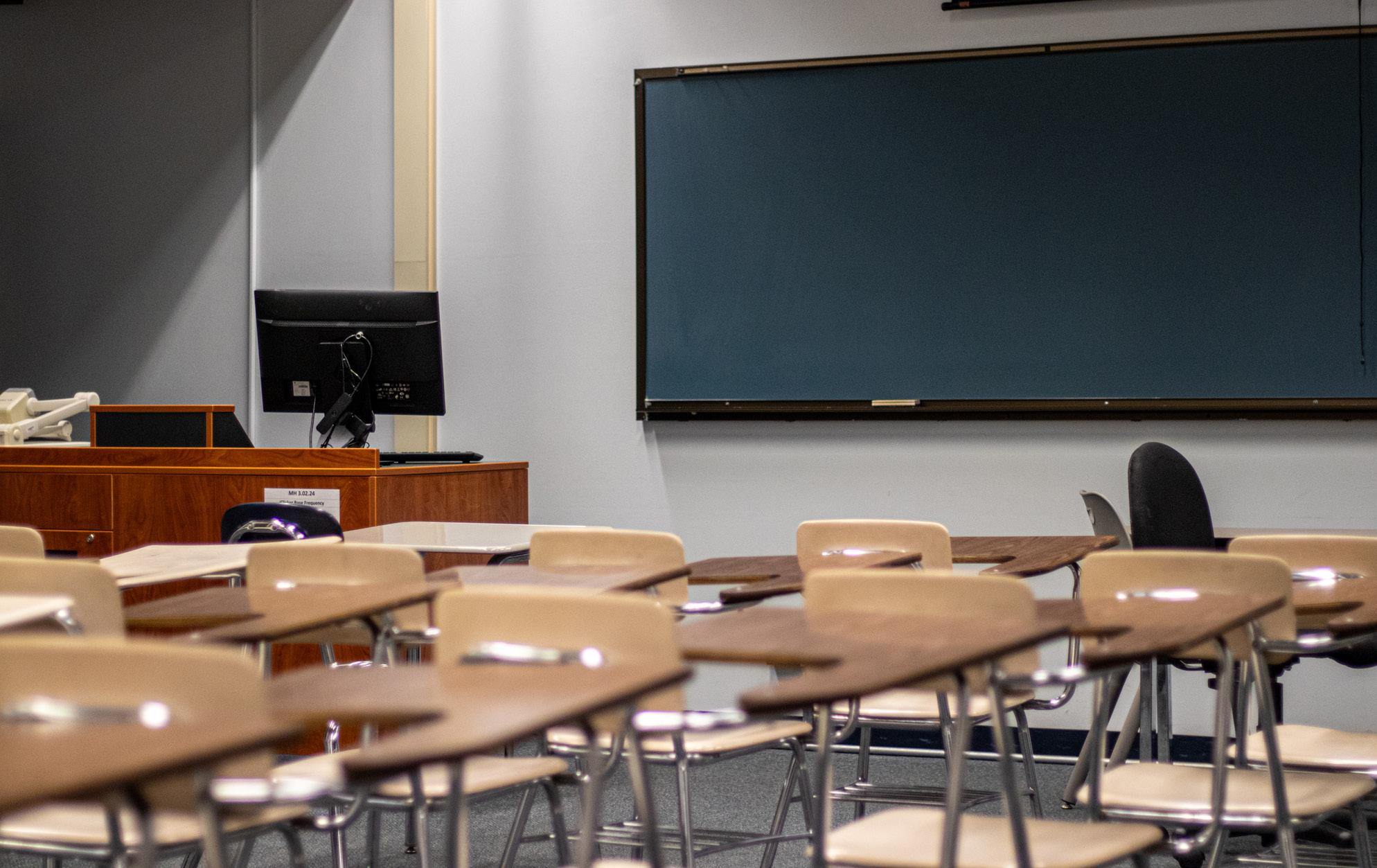
UT San Antonio’s HSI designation has resulted in the university being invited as a founding member of the Alliance of Hispanic Serving Research Universities. This is a group of institutions that are federally designated as HIS and R1 universities. UT San Antonio was also honored as a recipient of the Excelencia in Education with a Seal of Excelencia in 2020.
Defunding HSIs will result in loss of financial resources, such as reductions in academic support, infrastructure and possibly raise tuition costs. The reduction of resources could possibly delay graduation rates, increase attrition and shrink opportunities for students.
“Cutting this funding strips away critical investments in under-resourced and firstgeneration students and will destabilize colleges in 29 states,” said David Mendez, Interim CEO of the Hispanic Association of Colleges and Universities.
“This is not just a budget cut, it is an attack on equity in higher education. The funds granted to HSIs have never supported only Latino students. These funds strengthen entire campuses, creating opportunities and resources that benefit all students, especially those pursuing STEM fields, as well as enhancing the communities where these colleges and universities are located,” Mendez continued.
UT San Antonio declined to comment on this matter.
Diego Cisneros/The Paisano
Rylan Renteria/The Paisano
Miles Jones/The Paisano

nutritional education, fitness
By Roxanna Rodriguez
Health and Human Services Secretary Robert F. Kennedy, Jr. traveled to Austin and met with Gov. Greg Abbott, who signed a series of health-related education and nutrition bills into law last month.
There were three bills included in the “Make Texas Healthy Again” Act.
Senate Bill 25 requires food label transparency for consumers and implements nutrition education across K-12 schools, higher education and the health care workforce.
Any food product sold in Texas must include a clearly visible warning label if it contains one or more of 44 specified additives — such as bleached flour, Red Dye No. 3, BHA, titanium dioxide and other colorants, preservatives and synthetic compounds.
The required label must read, “WARNING: This product contains an ingredient that is not recommended for human consumption by the appropriate authority in Australia, Canada, the European Union or the United Kingdom.”
The bill also mandates that schools offer daily physical activity for students from kindergarten to eighth grade and prevents faculty from restricting recess to students as a punishment.
For higher institutions like UT San Antonio, SB 25 requires nutrition education for all students enrolled in an associate or baccalaureate program in medical or healthcare service fields.
Senate Bill 314 stops schools in the National School Lunch and Breakfast Programs from serving free or reduced-
price meals that contain certain additives — such as Red Dye No. 3, BHA and titanium dioxide.
Senate Bill 379 prohibits individuals from using Supplemental Nutrition Assistance Program benefits to purchase energy, sweetened or carbonated beverages and certain packaged chips or cookies. All three bills went into effect Sept. 1.
“This is one of the most prolific bipartisan pieces of legislation that was passed this session,” Abbott said. “Doesn’t matter if you’re a Democrat, Republican, whatever the case may be, every legislator in Texas wants to see Texas be put on a pathway to be healthier, and these laws that I’m signing today chart that pathway.”
According to a report by The Michael & Susan Dell Center for Healthy Living, Texas has the sixth highest obesity rate for children ages 6-17 in the U.S. The study found 29% of school-aged boys have obesity compared to 22% of girls in Texas, and one in four of school-aged children and adolescents in Texas have obesity, compared to one in five students in the U.S. One of the key highlights in this study suggests fostering healthy habits and encouraging healthy behaviors are essential to preventing childhood obesity.
Kennedy applauded Texas leaders for supporting his “Make America Healthy Again” initiative, saying the state is setting the standard when it comes to removing harmful additives and promoting better nutrition.
“I’ve been to many states, but there is no state — maybe with the exception of Louisiana — that has passed legislation this far-reaching,” Kennedy said at the event, highlighting Abbott’s signing of senate bills 25, 314 and 379.

By Lourdes Czechowicz Contributor
Week of 9/9
Not subscribed to local news but still want to stay up-to-date on the happenings around town? Look no further. Highlighting notable stories from external San Antonio news sources, State of the City summarizes the most captivating news headlines of the week. This week’s topics cover ransomware attacks, federal education funding and taxpayer savings.
‘Bexar Gives Back’
Sheriff Javier Salazar and a panel of judges showcased a check for $2.2 million, highlighting how much taxpayers have saved since the ‘Bexar Gives Back’ program
women’s bathroom],” when questioned about their interpretation of the Senator’s conservative Texan legislators place the concern of women’s safety at the heart of the bill, opponents of the bill argue that it has no clear implementation
President of the Human Rights Campaign, Kelley Robinson, explained in an article that “[SB 8] represents a dangerous government overreach and is impossible to enforce without exposing people to humiliating inspections and worry that the bill would incite harassment against trans individuals and cause people who identify with their sex at birth to be questioned about their gender. As the UT San Antonio Student explained, “[SB 8] is just hate towards trans people under the guise of women’s
“Texas Women’s Privacy Act” bill was passed in the Senate, and the House’s increase of penalties makes SB 8 one of the strictest bathroom bills in the
The Catholic church has canonized its first millennial saint: Saint Carlo Acutis. In June, Pope Leo XIV held an Ordinary Public Consistory — a meeting between the Cardinals — to vote on the possible canonization, or officiation, of eight blesseds, the step before sainthood. Acutis got approved, and on Sept. 7, he, along with Pier Giorgio Frassati, was canonized to be the Catholic church’s newest saints.
Acutis passed away in 2006 from leukemia at age 15. The boy was devout in his faith from a young age, attending Mass daily to receive the eucharist. As the first new-age saint, Acutis displayed his faith through technology. He preached the Gospel to his friends over video games and created a website sharing Eucharistic miracles of the church.
His canonization was dependent on having performed two confirmed miracles. The first was confirmed in 2020 by former Pope Francis. Acutis was cited as having healed a boy named Mattheus Vianna, who suffered from a life-threatening congenital condition. Luciana Vianna, Mattheus’ mother, attended a service dedicated to Acutis in 2013, praying to the not-yet saint to heal her son. The boy touched his picture, told Acutis his prayer and was reported to have been cured even before arriving home.
The miracle that qualified Acutis for sainthood involved healing a woman who suffered brain damage after a biking incident. The woman, Valeria Valverde, was in critical danger due to her injuries. Her mother, Liliana Valverde, traveled to
Acutis’ tomb to pray to the blessed, and received news from the hospital later that day that Valeria had taken a major turn for the better. The millenial canonization was postponed due to Pope Francis’ death, but the new Pope Leo XIV set the September date. About 80,000 people showed up for the event. His body can now be viewed in a glass tomb in Assisi, Italy, where many go to pray and ask him for intervention in their lives. He is dressed in blue jeans and Nike sneakers, a reminder that he came from the 90’s.
File Photo/The Paisano

launched in 2020. The initiative has allowed judges involved in the program to sentence any nonviolent misdemeanor case offenders to supervised community service. This prevents many individuals from being sentenced to jail time, saving taxpayer dollars. Salazar estimates over a couple hundred people have gone through the program, with upwards of several dozens active at a time. The $2.2 million figure unveiled on Sept. 9 combines the money saved on jail days and the added value of the community service completed.
4 dead, 6 wounded over the weekend
Three shootings over the weekend left four dead and six with gunshot wounds, San Antonio Police Department reports. A 35-year-old man was found dead at an apartment complex near San Fernando Street and South Colorado Street. No suspects have been found. Two men were found dead on Sunday morning at an apartment complex on Callaghan Road near Loop 410. The fourth and final death of the weekend occurred at a downtown parking garage on East Commerce Street, right outside the Shops at River Center. SAPD claims the incidents are unrelated and isolated. Crime rates have remained near equal to last year, with 86 homicides this time last year, compared to 83 this year.
Uvalde CISD under attack
The Uvalde Consolidated Independent School District will close its doors this week due to a ransomware attack on school servers. Access to essential systems like phones, camera monitors and AC controls were crucially affected, making the schools indistrict unsafe for students and teachers. All classes, including dual-credit courses with Southwest Texas College, will be paused until Thursday, Sept. 18. The attack has been reported to the Federal Bureau of Investigation and the insurance cybersecurity team. The source of the attack is currently under investigation.
Carlo Acutis will be the first millenial saint in history.
Diego Cisneros/The Paisano
Contributor
OPINION
End ICE’s reign of terror
SCOTUS ruling; budget increases give agency unchecked, unprecedented power
Editorial
The U.S. Immigration and Customs Enforcement Agency has become the most funded, expansive and powerful law enforcement agency this nation — and possibly the world — has ever seen under President Donald Trump. ICE has already been granted a massive warchest, in the form of a $75 billion budget increase under the Big Beautiful Bill, to carry out Trump’s mass deportation agenda. Now, the Supreme Court of the U.S. has further increased its power over citizens and non-citizens alike to an extremely dangerous level.
In a 6-3 temporary ruling along partisan lines, SCOTUS overturned an injunction by a lower court that prohibited ICE from stopping, questioning and detaining individuals without probable cause based on racial stereotypes, without an explanation from the majority. The judge found ICE agents were stopping predominantly Latino individuals, who spoke little English or had Spanishspeaking accents at bus stops, car washes and Home Depot stores in Los Angeles. According to Justice Sonya Sotomayor, these actions go against SCOTUS’
precedent, which historically prohibited ICE from using ethnicity as a sole or determining factor to make stops when seeking undocumented migrants or non-citizens.
“We should not have to live in a country where the Government can seize anyone who looks Latino, speaks Spanish and appears to work a low
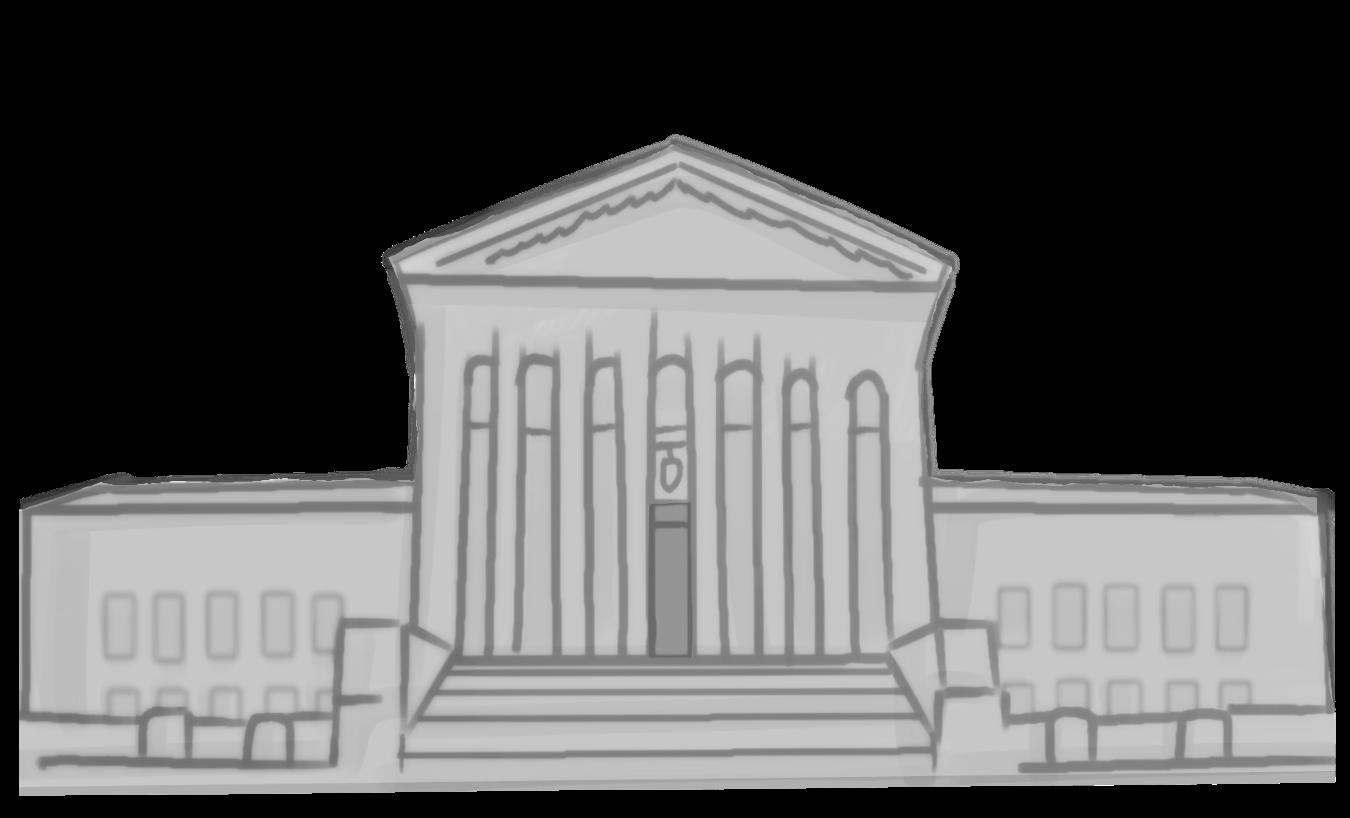
wage job,” Sotomayor wrote in the court’s dissent.
In granting this injunction, SCOTUS has given ICE the all-clear to stop any individual who looks or sounds Latino, or fits common Latino stereotypes. In a nation where 23%
SB 17: Xenophobia over Texans
Commentary
By Johnpaul Buwule Staff Writer
The Texas Legislature passed the xenophobic Senate Bill 17, which took effect on Sept. 1, giving the Texas governor the power to determine which countries’ residents can be restricted from owning land in Texas, including organizations that Gov. Greg Abbott deems to be criminal organizations. The move is reflective of the current state of national politics, in which xenophobic rhetoric has taken the form of legislative and political action.
“Securing Texas land and natural resources and making sure that this precious resource does not fall prey to adversarial nations and oppressive regimes that wish to do us harm,” Texas Representative Cole Hefner said in defense of the bill.
Any entity or individual in violation of SB 17 could face a civil penalty of $250,000 or 50% of their property market value and could even face felony charges. The law associates the individual with the actions and sentiments of their government, which is not reflective of the person’s views, values or beliefs — painting foreigners as inherently adversarial.
However, foreign land ownership is not a threat to Texas’ economy or security. According to the United States Department of Agriculture’s 2023 annual review, foreign investors from the biggest adversaries — China, Iran, Russia and the Democratic People’s North Korea — accounted for less than 1% of agricultural land held in the U.S. Americans are not suppressed or at a competitive disadvantage by foreign investment.
SB 17 will do more harm to Texas’ land value than preserve it. The USDA found that states without restrictions on foreign ownership “experienced an above-average growth in agricultural land values,” roughly around 4.6% annually, while states with restrictions experienced below-average growth in land value. In comparison to the rest of the U.S., Texas has a large presence of foreign land ownership, approximately 5.3 million

acres owned in foreign ownership; thus, SB 17 presents a clear and present danger to Texas’ economy, especially considering that land value has increased under the presence of noncitizens owning land.
This xenophobic bill does not simply limit foreign entities but allows for the Texas government to target individuals, primarily affecting Asian land owners who are citizens of another country. Asian investors are one of the biggest landowners in Texas, with Chinese investors owning 123,708 acres in Texas. China is one of the U.S’s biggest adversaries, and with foreign nationals owning large sums of land, Asian landowners will be caught in the crosshairs of this law.
The law is reminiscent of the Alien Land Laws of the 1960s that, just like SB 17, prohibited land ownership by residents ineligible for citizenship, targeting non-white immigrants. The 1960s law was racially neutral in language, but in practice, it produced gross racial inequality, and SB 17 is no different. The bill is only a variation of a practice that has a long, racist history, except that the rhetoric justifying it is disguised as security. SB 17 not only targets U.S. adversaries but creates them out of U.S. citizens born in other nations.
SB 17 is a regressive policy drenched in xenophobic racism set to limit foreign landownership while curbing foreign investment — a necessity to Texas’ economy. SB 17 will work to create a less diverse economic pool, all because the Texas Legislature is clouded by its own ignorance.
of the population is Hispanic or Latino, this brazenly racist policy implemented by ICE is going to lead to the wrongful detainment and deportation of U.S. citizens. Masked, unidentifiable ICE agents have carried out Trump’s agenda, brutalizing and terrorizing Latinos regardless of their legal status. While ICE claimed this injunction acted as a “straitjacket” to their enforcement capabilities, it was an essential safeguard of due process for Latinos across the nation. U.S. citizens — including children — have already been wrongfully deported by this administration. This ruling will increase these instances tenfold. It is not illegal to be Latino in the U.S. It is not illegal to primarily speak Spanish in the U.S. It is not illegal to work low-wage jobs in the U.S. Trump cannot make these things punishable just because he wants to. ICE is a dangerous agency that is drunk with power. It cannot continue to operate in this manner. This violent arm of the state must be reined in to protect the right to due process — and the dignity — of all Latinos in the U.S.
‘Defense’ to ‘war,’ Trump’s $1 billion name change
Commentary By Lina Arraour Contributor
U.S. President Donald Trump signed his 200th executive order on Sept. 5, with the hefty price tag of an estimated $1 billion. It is not healthcare, nor reform, but a name change: the Department of Defense will once again be called the Department of War.
As newly-appointed Secretary of War, Pete Hegseth, declared, “We’re going to set the tone for this country: America first, peace through strength.”
Hegseth’s vision stands in direct contradiction to why former President Harry Truman changed the department’s name in 1948. In the wake of World War II, the name “defense” was chosen to usher forward an era of peace within the U.S., communicating to international adversaries that the nation’s mission is protection, not perpetual warfare. The change also unified the Army, Marine Corps and Navy under one branch, emphasizing cooperation over aggression.

To return to “war” is more than just semantics. It projects a political ideology onto an institution designed for protection, disregards a long history of American military tradition and undermines Truman’s core message: American strength lies in peace, not through glorified combat.
Although this legislation may seem like mere wording, Politico projects the change will cost $1 billion — hardly
symbolic to U.S. taxpayers. Trump frames this change as a correction to a “woke-y” defensive strategy, surmising, “it’s really about winning.” Given the nation’s increasingly aggressive stance in conflict zones — like Israel, Ukraine and the Panama Canal — this rebrand looks less like historical revisionism and more about openly embracing a new, offensive doctrine.
The price tag, $1 billion, could build highways, fund flood mitigation, drive transformative scientific research or conserve fragile ecosystems. At home, Americans face a continuous housing crisis, a shaky economic market, regular school shootings and the looming shadow of global warming.
As Senator Tammy Duckworth, a military veteran, told Reuters, “Why not put this money toward supporting military families or toward employing diplomats that help prevent conflicts from starting in the first place?”
The truth is on our streets. Veterans make up a disproportionate amount of the homeless population in the U.S., undermining the outstanding sacrifices these service members made for this nation — one supposedly committed to its citizens’ protection.
The decision to pivot and prioritize defensive strategy is a reflection of Trump’s administration thus far. Reform is what citizens demand and require. Domination is what the administration delivers.
Names matter. They shape identity, history and intent. By trading “defense” for “war,” America tells the world –- and itself — that it no longer hides its fists behind open hands. America is preparing to swing.
Ayo Edebiri’s classy and empowering response
Commentary
By Edmond Cartagena Contributor
During an interview held at the Venice Film Festival, journalist Federica Polidoro interviewed Andrew Garfield, Julia Roberts and Ayo Edebiri for Luca Guadagnino’s upcoming film, “After the Hunt.” Polidoro overstepped in her journalistic pursuits by inquiring about “What we lost in the politically correct era” and “What to expect in Hollywood after the Me Too movement and the Black Lives Matter movement are done.” Polidoro followed this by mentioning that it was only directed towards Garfield and Roberts; notably, Edebiri was the only Black woman among the trio of talented actors. The Emmy-winning actress responded
with class and respect despite the reporter’s ignorance. Edebiri stated, “I don’t know if it’s purposeful if [the inquiry] is not for me, but I don’t think it’s done. I don’t think it’s done at all. Hashtags might not be used as much, but I do think there is work being done by activists, by people every day.” Her co-stars were supportive of her response, appearing happier to have Edebiri respond to the controversial statement rather than them.
Luca Guadagnino’s film starring Roberts, Garfield and Edebiri revolves around themes of racism, sexual abuse
and deception. These cinematic themes are an open door for progressive questions rather than restricting ones, which makes Polidoro’s inquiry awkward. The Italian journalist could have

still a global problem. Polidoro rejected the reality of two extremely active movements that advocate against important world issues. The reporter’s ignorance shows that some individuals still have closed minds when it comes to issues such as sexism and racism. These issues are still very much alive, especially if a journalist is willing to make such a statement during a recorded interview.
Edebiri handled Polidoro’s disrespect appropriately. She could have handled Polidoro with much less grace; however, her kindness reflected a professional tone of advocacy for both movements. The #BlackLivesMatter and the #MeToo movements will continue until all voices are heard equally, and as Edebiri stated, “There is [still] work being done.” It is likely that these movements will live on for generations to come
Milagros Regalado/The Paisano
Kara
Lee/The
Paisano
AliciaMartinez/The Paisano
Kara Lee/The Paisano
OPINION
Censorship disguised as safety
Commentary
By Emily Loredo Contributor
89th Texas Legislative session

Storm Goodman/The Paisano
libraries, the creation of library advisory boards and the expansion of parental rights regarding catalogs and children’s access. This reshaping of the public school library
No
system is rooted in the idea that protecting community values and parental rights holds a high value in children’s education. Nonetheless, this raises concerns of censorship, governmental overreach, and threatens the educational autonomy of our prohibits public school library material that contains “profane” or “indecent” content. However, these standards for exclusion are extremely vague; what one might believe is “grossly offensive language” can vary from person to person. Books that most Texas students have grown up reading in class, such as “To Kill a Mockingbird,” or just for fun like “The Hunger Games,” can be argued to contain profane and indecent content. Literature regarding race, prejudice, power and mortality can be completely wiped from the public school system. greater concern is parental access and control of not only their child but all children at the selected school. The bill allows parents access to a full catalog of available material, the right to submit a
punishment meted out for fake electors
Commentary
By Kassandra Jaime Contributor
Several Republicans have escaped electoral accountability after Michigan Judge Kristen Simmons dismissed all charges imposed on them regarding forgery and conspiracy during the 2020 election. This decision resulted from a “lack of sufficient evidence to prove intent.” On Sept. 9, Michigan Attorney General Dana Nessel announced that all suspects would face criminal charges for their involvement in election forgery.
“They tried to steal the votes of millions of Michiganders. If they can get away with this, what can’t they get away with next?” Nessel said.
In response, Simmons said that the case lacked orchestrated schemes despite the prosecutors exposing the republicans in question would sign documents in secret and claim to be chosen to represent Michigan. Investigators also confirmed the group of Republicans had met at the Michigan GOP headquarters to falsely sign documents stating they were the “duly elected and qualified electors.” Simmons explained how no justifiable criminal charges were imposed upon the suspects in 2023.
They were “Savvy or unsophisticated enough to understand the electoral college,” Simmons said. She spoke on a subject that benefited the same president who advocated for his supporters to contest the results, leading to the insurrection in the U.S. Capitol on Jan.
6, 2021, after losing the election to former President Joe Biden.
The existence of falsely signed electoral votes became even more relevant after this tragedy, igniting Democrats like Nessel to come forward with a stance on the case.
While the case was dismissed this year, its dismissal does not undo the fact that the incident happened at a time of distress and conflict between two political parties.
list of material their child is not allowed to check out and access to a record of the child’s library check-out history. In theory, a parent should have a say over their child’s access to explicit content; however, sometimes school is an escape for children from a suppressive and restricting household, especially in Texas. Furthermore, it requires school districts to create Local School Library Advisory Councils, where the majority of voting members must be parents appointed as members. The purpose of such counsel is to uphold “community values” when selecting which books belong within the library. However, these values can vary from district to district and open the door to ideological policing of literature of all children based on the ideologies of a select group.
It is becoming difficult to define the difference between youth safety and youth censorship. Education is not supposed to be safe, in the sense that some literature is uncomfortable, supports challenges, and illuminates new ideas. Access to these books should not be restricted based on one individual’s worldview.

“This was, in my belief, a coordinated attempt to overturn the will of the American people,” Nessel said after a disappointing case against the Republicans.
To conclude the case, only one proTrump elector was convicted of the crime, Lorraine Pallegrino, who cast a falsified vote in the state of Arizona. The other 15 Republicans were set free without punishment.
It can be hard to identify exploitation by individuals who secure congressional positions at the expense of the votes cast by American civilians, as a vast majority of Americans are unaware of electoral college guidelines; however, it is crucial to secure the integrity of every election.
Electoral fraud is no more than an attempt to subvert or manipulate the electoral process, which is exactly what happened in the case just dismissed by Simmons.
These actions went against 52 UCS 20511: Criminal Penalties Section 2, which states a violator is an elected official who “knowingly and willfully deprives,
defrauds or attempts to deprive or defraud the residents of a State of a fair and impartially conducted election process.” The final feedback given by Nessel was that her office would consider an appeal for the case.
While Simmons has chosen to interpret this case as nothing but an execution of their constitutional rights, the case must remain open until a concluded verdict imposes consequences on the Republicans who took part in such heinous actions.
The idea of setting aside such a pivotal case leaves American voters unsure of their voting power in upcoming elections.
The fundamentals of an electoral college are meant to cater to the priorities and concerns of American civilians; instead, it has been used to empower presidential status. The efforts of these Republicans to debunk the votes of other ballot casters are unethical and expose the wrath of unfair and impartial voting tactics.
Chloe ’s succession to Vogue’s throne
Commentary
By Valentina Quintanilla
Graphic Artist
Dame Anna Wintour’s 37-year reign has come to an end. The former Editor-inChief of American Vogue has passed the title of Head of Editorial Content to the Editor of Vogue’s website and co-host of The Run-Through with Vogue podcast, Chloé Françoise Malle.
Although Malle has always been a writer for different newspapers and magazines, her nepotistic background has stirred controversy; some question whether she is worthy of the editor title. However, it does not matter what one’s background is, as long as one has the creativity and the passion for their work.
Malle, daughter of actress Candice Bergen and French director Louis Malle, has led a journalistic life since her time at Brown University, where she wrote for The Brown Daily Herald. After receiving her B.A. in Literary Arts and Comparative Literature, she worked for the New York Observer, mostly covering real estate. Later on, she contributed to the style section at The New York Times and later contributions for Vogue.
After her contributions to Vogue, she
was appointed to the role of Social Editor in 2011, where she led wedding and social coverage, also contributing to a wide range of topics — including fashion, politics, homes and gardens, beauty and
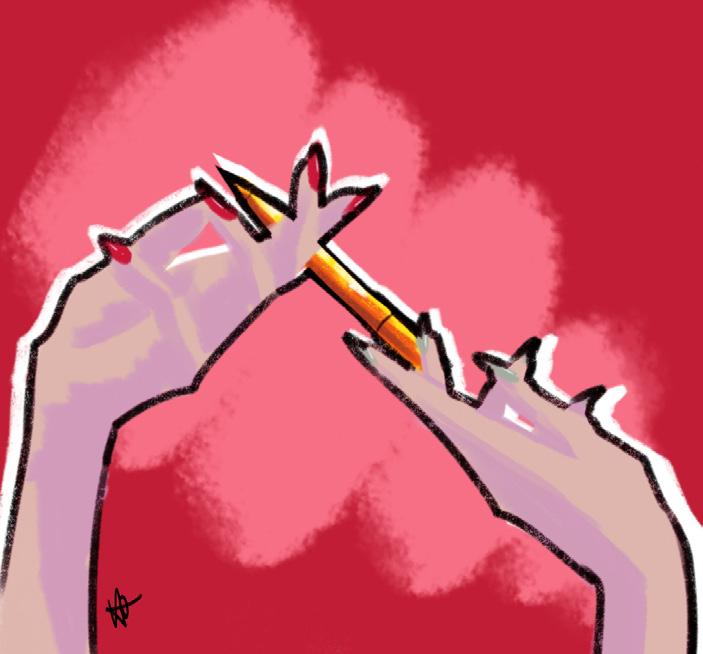
health. Her contributions to Vogue led to her becoming Editor of Vogue.com in 2023, where she helped the page grow in numbers and views by implementing coverage of major events, such as the Met Gala and Vogue World.
Although Malle’s experience in the fashion world has been notorious, internauts are skeptical of Wintour’s choice of Malle for Head of Editorial Content. Many state that her connections
The Paisano
Luna Infante | Opinion & Magazine Editor Opinion@paisano-online.com Magazine@paisano-online.com
Christopher Delgado | Arts & Life Editor Arts@paisano-online.com
Rylan Renteria | Sports Editor Sports@paisano-online.com
and background have heavily impacted her success in obtaining her new role.
Malle has admitted she is a “proud nepo baby” in an interview with The New York Times.
“There is no question that I have 100 percent benefited from the privilege I grew up in. It’s delusional to say otherwise,” Malle stated.
Malle’s connections and background impacted her career, helping her obtain roles in major publishing houses, but her effort and visionary ideas for Vogue prompted Wintour to choose Malle as her successor.
Although Malle’s first works as Head of Editorial Content have seemed odd — integrating AI Models and featuring Lauren Sanchez’s wedding on the front cover — her ideas and goals for Vogue have pleasantly surprised and thrilled the public. Her goal of “original, witty, irreverent, joyful points of view” on a variety of platforms, innovating on a more modern and up-to-date version of Vogue, has filled people with anticipation.
Vogue’s new leadership might have shown a slow start, but Malle’s passion and expertise for the field will not disappoint. After all, the pursuit of lasting excellence is not to be rushed.

The
The Paisano is published by the Paisano Educational Trust, a non-profit, tax exempt, educational organization.The Paisano is operated by members of the Student Newspaper Association, a registered student organization. The Paisano is NOT sponsored, financed or endorsed by UTSA. New issues are published every Tuesday during the fall and spring semesters, excluding holidays and exam periods.The Paisano is distributed on the UTSA Main Campus. Additionally, Paisano publications are distributed at a variety of off-campus locations, including Tripoint and a variety of apartment complexes near the UTSA Main Campus. All revenues are generated through advertising and donations. Advertising inquiries and donations should be directed to: 14526 Roadrunner Way Suite 101 San Antonio, TX 78249 Phone: (210) 690-9301 © 2025 The Paisano The University of Texas at San Antonio’s Handbook of Operating Procedures states in 5.03 that: The University of Texas at San Antonio (UTSA) will not exercise control over the format or content of Student Publications, but will regulate distribution on campus. Student Publications will be free of censorship and advance approval of copy, and their editors and managers are solely responsible for editorial and content policies and decisions. Editors and managers of Student Publications will not be subject to arbitrary suspension/expulsion or removal from their positions within a Registered or Sponsored Student Organization (Student Organization) by the University because of student, faculty, administrative, or public disapproval of editorial policy or content. Student Organizations that distribute Student Publications are afforded the same rights and privileges as Student Organizations that do not distribute Student Publications.
Editorial is the official opinion of The Paisano editorial board.
Marcela Montufar Soria/The Paisano
ARTS & LIFE
Performing Tejano ‘Stories of Resilience’
By Lourdes Czechowicz Contributor
The Guadalupe Cultural Arts Center will present “Nuestras Voces: Stories of Resilience,” an original, multidisciplinary production at the UT San Antonio Downtown campus’ Buena Vista Theatre on Sept. 20. Nuestras Voces highlights five of San Antonio’s most influential activists and Mexican American leaders: Lydia Mendoza, Emma Tenayuca, Americo Paredes, Willie Velasquez and Jovita Idar. The show follows these pioneers in chronological order as they paved the way for change in Texas.
Education Director for the center and cast member of the production, Belinda Menchaca, explained how the five activists were selected.
“We just felt very strongly about their Texas origins, the fact that we could somehow demonstrate and bring their life to stage through dance, and then just Mexican-American leaders that people can relate to and that would inspire,” Menchaca said. “We feel like their stories inspired us, and we want to inspire our community as well.”
Mexican American history in Texas has always been a huge theme for the Guadalupe Cultural Arts center. UT San Antonio, a Hispanic-Serving Institution, serves as the perfect setting for this production. It benefits from these stories of representation and strength in Mexican-American culture.
In its 34 years, the Guadalupe Dance Company has made significant efforts through their art to amplify MexicanAmerican voices with original works by the team. The company blends different dance styles together, based in folklorico with touches of contemporary dance throughout their choreographies. Audiences learn forgotten histories of the Mexican-American pioneers of San Antonio through dance and music.
“Our first major production was in 1994, and it was called Rio Bravo,” Menchaca recalled. “It was a chronology of music and dance of the South Texas border with Mexico, and so it’s a chronology of very primitive dance all the way to Tejano dance.”
“Nuestras Voces” will feature students of the Guadalupe Cultural Arts Center’s dance company, accompanied by live musicians from Mariachi Azteca de America to deliver a
powerful performance about the struggles of prominent women in Mexican American history.
A 15% off discount is available for students on general admission tickets only through show time on Sept. 20. Use the education discount code - NVEDU at checkout.
“Nuestras Voces” is open for one night only on Saturday Sept. 20 at 7:30 p.m. The production will take place in the Buena Vista Theatre at UT San Antonio’s Downtown Campus located at 501 W César E. Chávez Blvd.
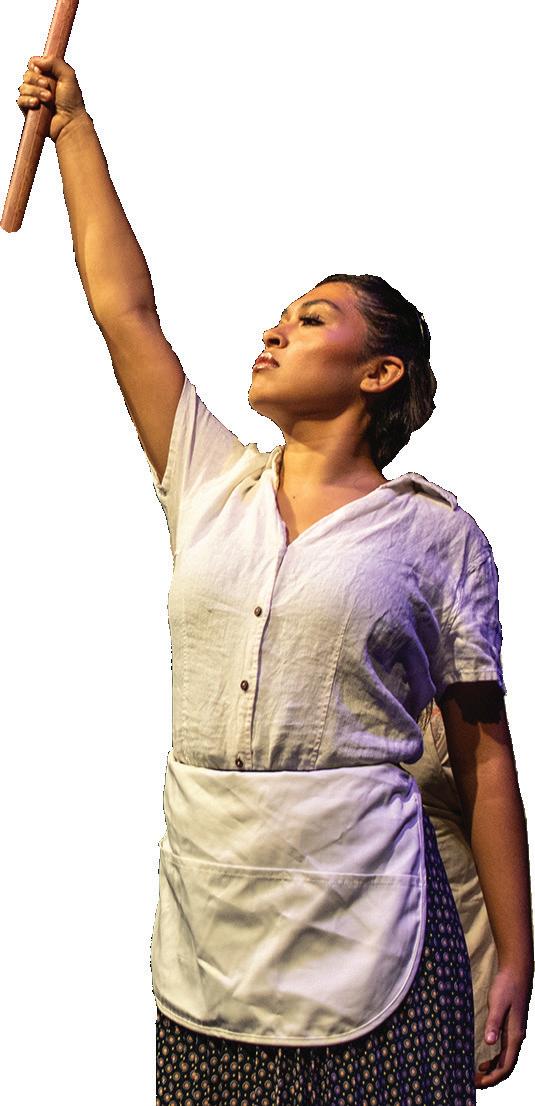
Art staff explores biology, theology and technology
By Diego Martinez Contributor
On September 10, the XXII Biennial Faculty & Staff Exhibition had its opening reception in the UT San Antonio Main Art Gallery. The exhibition features art work across numerous mediums, showcasing the individual abilities, perspectives and work of the UT San Antonio School of Art faculty and staff.
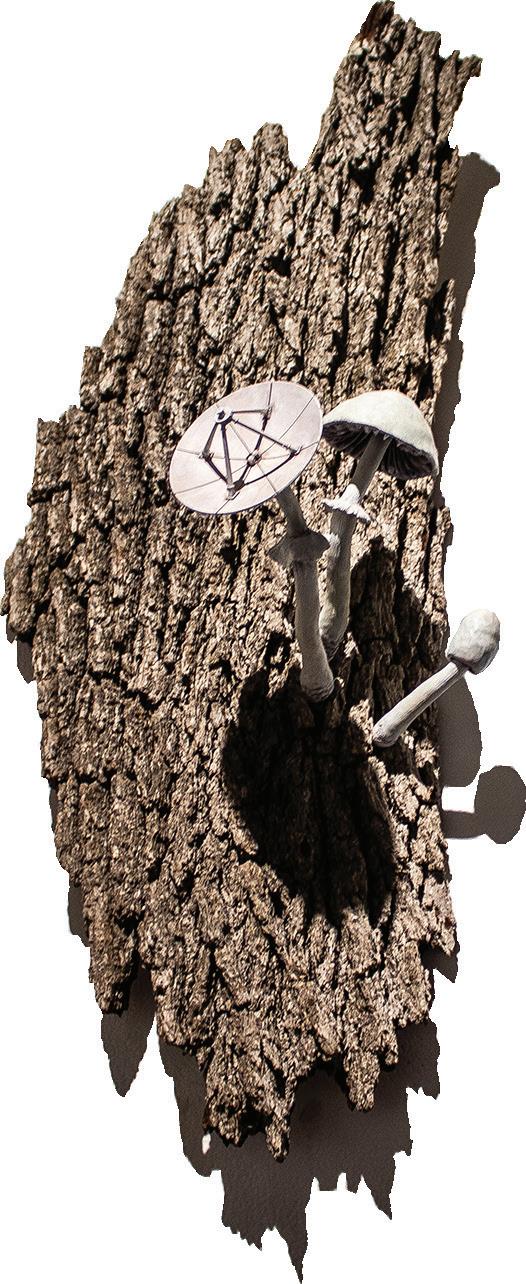
Professor Chris Sauter displayed a piece titled “Transmitter / Receiver” made in 2024 of a 3D printed polymer clay, paint and tree bark. Sauter’s work shows a satellite dish attached to a piece of tree bark with mushrooms stemming from the same piece of bark. Sauter’s background explores the links between biology, culture and the dissonance of time.
“Transmitter / Receiver” is a perfect example of links between the past and present, juxtaposing the tree bark and mushrooms’ longevity on Earth with a man-made satellite dish facilitating modern communication.
Professor Alán Serna showcases a piece titled “El Paño Poderoso (The Powerful Bandana)” made this year of a cyanotype on a bandana. The
cyanotype shows a gardening glove over the outline of somebody wearing a sweater. The top right corner has text with a heading reading “ORACION A LA MANO PODEROSA (Prayer to the Powerful Hand).”
The subsequent text reads the prayer mentioned in the heading, following imagery and a prayer card for “La Mano Poderosa,” which is a Catholic prayer with a depiction of Christ’s hand with figures of Jesus, the Virgin Mary, Saint Joseph, Saint Joachim and Saint Anne.
The prayer is looking for mercy in a distressing situation to open paths that are beneficial. God is asked to forgive past mistakes and give the worshipper strength to tolerate inconveniences of life. The prayer must be recited for fifteen days. Eight days after this prayer is completed, all prayers are answered, no matter how difficult. Serna notes that this prayer is made in hopes of new opportunities and fresh beginnings.
Bri McDonald displays a six-minute-and-33-second film titled “TEOTWAWKI Road,” the initialism reading “The End Of The World As We Know It.” Materials are listed as AI video, stolen identities and family hallucinations. The film follows the premise of a girl named Bri looking for her parents in a post-apocalyptic world where she is walking down a never ending road.
Bri runs into a friend who says that they need to find her parents. She runs into her mother who gives her a “life straw” to remove impurities from her. When she obtains this life straw, a voice off screen says, “Hey, we’ve heard you’ve got the good stuff — the stuff we’ve been waiting for.” The voice is odd and creates a sense of urgency.
Later down the road, she encounters her father who gives her nicotine patches. He says not to trust “them,” which could be interpreted as the voices off screen asking her for the “good stuff.” She then begins running, but another off screen voice says she is going the wrong way. The scene changes to a deer who presumably takes Bri’s place with a different girl named Grace shown with blood on her hands and a gun in her hands after crossing paths with that deer.

With the odd nature of AI’s audio and video capabilities,
this film displays a dystopian world that is made to seem more frightening with the stolen identities used to create it. This could also be a commentary on the artists’ own identity as it follows the path of a girl named Bri. She is lost in this postapocalyptic world, and nothing is trustworthy since everything is an imitation of real life.
Sauter, Serna and McDonald all draw inspiration from different fields of study and different values with their diverse backgrounds in fine arts as well as their personal lives, making this an amazing exhibit.
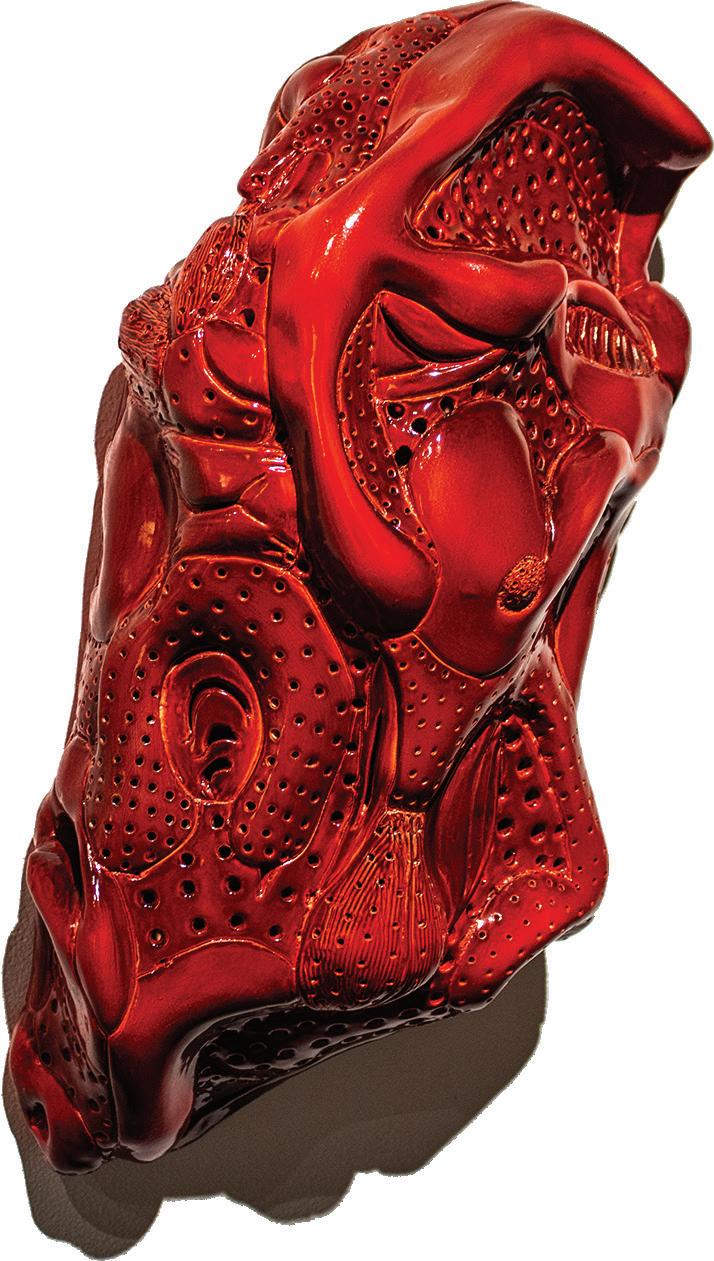
Of course, these are not the only amazing faculty members with art work on display. There are numerous sculptures, lithographs and paintings showing the diverse range of the College of Arts staff. This exhibit will be open in the Main Art Gallery through Nov. 1 and is open Thursdays through Saturdays from 10 a.m. to 3 p.m.
King Princess, get over it already
By Jasmine Williams Managing Editor
King Princess has once again proven she cannot grow out of creating pitiful songs longing for her exes with her third album, “Girl Violence,” released on Sept. 12. This album’s 13 songs and 34-minute runtime are its saving grace — any longer and listeners would be put to sleep by the superficial, sappy lyrics repeated to no end.
The title track reveals King Princess has unfortunately experienced intimate partner violence. While this is a shock to her, as she questions, “Why does nobody mention that girls can be violent,” IPV is rampant in the lesbian community, with 63% of women reporting they have experienced it. The 2-minute-15-second, sorrowful song felt entirely too long, with multiple elementary lines being repeated up to six times.
The next two tracks, “Jamie” and “Origin,” bring some intensity to the album with their resounding drums and heavy basslines. The instrumentals thankfully drown out the dull lyrics of “Jamie” towards the end, and the synths and violins of “Origin” are an enchanting sound for sore ears.
The only thing that sets “I Feel Pretty” apart from the rest of the album’s songs is the allusion to substance abuse in the last stanza. Otherwise, it is yet another instance of King Princess crying over a situationship gone wrong.
The next four songs, “Cry Cry Cry,” “Get Your Heart Broken,” “Girls” and “Covers,” are near unlistenable with how abysmal the lyricism gets. The first is the worst with its chorus being “You’re gonna cry, cry, cry when you hear this / And I’ll say whatever.” The songwriting is akin to “KIDZ BOP gone bad.” It is what you expect a melodramatic teenager lamenting over their high school breakups to create.
“Say What You Will” and “RIP KP” are the highlights of this release, which is not saying much.
The former has the only feature of the album, making Joe Talbot’s words a much needed breath of fresh air. In the latter, King Princess speaks of an ongoing relationship. This song is erotic, intense and edgy — encapsulating what the entire album should have been with a title like “Girl Violence.”
Listeners are only let down once more after hearing the next track, “Alone Again.” The opening lines are a prime example of the on-the-nose lyricism that an established artist like King Princess should have grown out of by her sophomore album, “Hold On Baby.” The lyrics stating “All my friends said, ‘Don’t instigate her’ / But I did it and now we’re right here” on a beat does not make it music. This song should have been a voice memo to her close friends. Her record label should have cut her studio time short.
“Slow Down and Shut Up” seems like it will bring some energy to the album with its immediate poppunk sound, but King Princess starts singing. The chorus, “Slow down and shut up / Cause it’s you that I want,” is unimaginative and played out. All King Princess ever does in her songs is want someone, but nine times out of ten, they do not want her back.
The final song, “Serena,” is yet another lamentable ballad about pining and yearning that cannot come any sooner. It is a disappointing snoozefest to end a monotonous album.
“Girl Violence” should have been a sapphic, poppunk masterpiece skirting the edge of acceptability with lecherous lyrics detailing forbidden flings. Instead, it was a pathetic display of yet another miserable lesbian who cannot get over her exes.
Its release, coming three years after her last album, should have given King Princess ample time to grow her songwriting skills. A little bit of nuance, some double entendres and a handful of metaphors would have done wonders for “Girl Violence,” but the album was nearly devoid of lyrical merit. Incredible instrumentals have been wasted on an unremarkable album by the so-called “pop-singer” King Princess.
Miles Jones/ The Paisano
ARTS & LIFE
‘The UT San Antonio Pisser? We hardly know her’
The Pisser’s ‘rain’ is over
By Marisela Cruz News Editor
Last week, a recurring trend on TikTok emerged among college campuses across Texas. In these videos, anonymous figures appeared to urinate on public property on university grounds at nightfall. UT San Antonio became involved in this trend after a TikTok user dubbed “The UTSA Pisser” posted videos of themselves pissing at various locations around the Main Campus. The first video on the account was posted on Sept. 7 in response to UT San Antonio’s recent football loss to Texas State University.
The videos were taken down on Sept. 12, and the UTSA Pisser provided a statement on social media.
“It is finished. I was caught and I take full responsibility. To the students, thanks for having fun with it, but it ends here. To UTSA, I want to say I am sorry for the trouble. For anyone thinking of making copycat pages, please stop. Do not risk getting yourself in trouble for something so dumb.”
The pisser’s identity has remained anonymous. On Sept. 11, The Paisano was able to speak with the UTSA Pisser. They explained their reasons for choosing certain locations for their territorial markings.
“I pick them at random. There is no method to the madness. I am not worried about being caught,” the UTSA Pisser said.
During the interview, the UTSA Pisser wanted to relay a message to UT San Antonio regarding the incident.
“To UTSA, I want you to know this was never meant to be harmful. It was a joke, nothing more, and I hope no action is taken against me. I care about this place and respect it even if my way of showing it is unusual. Thank you for being the space we share these moments,” they said.
Emily LaQue, a graduate student pursuing clinical and mental health counseling, was entertained by the videos.
“At first I thought it was funny, because I was like, ‘It
Decompress, football and clubs
By Jasmine Williams Managing Editor
UT San Antonio students are abuzz the third week of the semester with talks of who the UTSA Pisser could be. The football team redeemed themselves after defeating the University of Incarnate Word at home 48-20, but it is unclear if they can keep up the momentum. What could be on the Roadrunners’ minds?

can’t be real, right? There’s no way that someone’s actually peeing all over campus,” LaQue said. “They might have seen this online and decided, ‘Wouldn’t it be funny if I did this at UTSA?’ and they had their 5-10 minutes of fame, and now
they’re in trouble. And they’re facing their consequences.” Regardless of whether students were amused or annoyed with the UTSA Pisser, it was fun while it lasted, but the humor-filled obscenity has come to an end.
Exploring the town on a budget

This week, The Paisano interviewed junior biology major Lauren Farmer, freshman mechanical engineering major Juan Pablo Rosco, freshman biology major Sanaia Fifer, freshman cyber security major Victor Gomez and junior biology major Mikey Hoyle.
What do you think the major is of the UTSA Pisser?
While the public pissing antics have been put to a halt, the questions surrounding the pisser’s identity persist.
Rosco is convinced it is economics, but Gomez argues it is psychology. Fifer and Hoyle both believe a business major is to blame. Farmer says, “Don’t come for me, but I’m gonna say engineering.”
How have you been decompressing after classes?
The coursework has only been piling up week after week. The ‘Runners are doing their best to cope with their own decompression go-tos.
Rosco and Fifer are less in tune with nature and opt for indoor activities. The former simply takes a nap, and the latter likes to doomscroll on Tiktok.
Hoyle is more productive with his time, sharing, “I have been journaling and working on myself.”
What clubs are you interested in trying out this semester?
Gomez stopped by a Filipino Student Association meeting recently, and he liked what he saw.
Hoyle did not hold back; he is looking into trying out six different clubs on campus. Rosco could not disagree more.
“I’m thinking about joining LATSA,” he said. “That’s it, the only one I’m gonna join.”
“One club I’m interested in joining is Black Women in Medicine. I haven’t joined yet, but hopefully I will,” Fifer says.
Who win in a matchup: UTSA Football or the Dallas Cowboys?
Fifer, Rosco and Hoyle all have faith in the ‘Runners this time around, but Farmer and Hoyle do not believe UTSA has what it takes.
“I don’t watch football, but I’m not gonna say UTSA, sorry,” Farmer admits.
“I’m not gonna lie, the Dallas Cowboys are whooping us, so I would say them,” Gomez states.
By Christopher Delgado Arts & Life Editor
As assignments pile up, it becomes necessary for students to decompress. One of the best ways to do that is by getting off campus and exploring the City of San Antonio. Here is how to explore the Alamo City while spending less than $10.
Transporting through town
Some major cities have a subway system — a cheap alternative to owning a car and buying gas. San Antonio has the VIA bus. Founded in 1977, VIA has been offering public transportation to the patrons of San Antonio for nearly 50 years. Bus fare costs $2.75 for a day pass, which is the best option for someone looking to make multiple stops.
However, UT San Antonio students receive a free semester pass with enrollment. Students can download the VIALink app and enter their university credentials to get the pass loaded into the app.
The VIA bus remains the most cost-effective form of transportation, even for those with cars. Parking fees and gas costs can be avoided. To view routes and plan a trip, download the Transit app for the most up to date and by the moment bus information.
Survey a UNESCO World Heritage Site
The San Antonio Missions, located in the South Side of San Antonio, are among 26 UNESCO World Heritage Sites.
Patrons can walk the Yanaguana Trail, which runs along the San Antonio River, to reach all the missions, including Mission Del Lago and the Alamo.
Within a mile radius of Mission San Juan, visitors can trek to the Mission Library and read a book or,
SA’s cultural food and music
By Diego Martinez Contributor
Hispanic Heritage Month takes place from Sept. 15 to Oct. 15 in celebration of the contributions, history and culture of the Hispanic diaspora across the U.S. San Antonio hosts many events throughout the month in honor of Hispanic Heritage Month.
Cuisine in San Antonio has an array of food offerings and has been designated a United Nations Educational Scientific and Cultural Organization Creative City of Gastronomy.
Plantaquería is a plant-based Mexican restaurant located downtown offering tacos, tortas and aguas frescas, clearly exemplifying the creativity of restaurant owners and cooks in San Antonio.
Located in the Pullman Market, Mezquite shows off the flavors of Sonora, Mexico. The restaurant offers ceviche, seafood, tacos and grilled meats. Currently, “Guac & Mezcal Nights” are held every Sunday and Wednesday evening. At the event, patrons are taught how to perfect their guacamole while drinking some Mexican Mezcal. There is also “Thursday Night Tequila Tastings + Mariachi” with a mariachi band performing while tasting curated tequilas.
San Antonio honors its history year round, but this month may be the perfect time to go out and see some cultural sites, such as the Casa Navarro Historic Site. The Casa Navarro Historic Site is the previous home
depending on the day, they can watch a movie at the Mission Marquee Plaza. This month, they are showing “Real Women Have Curves” and “In The Heights.” The Plaza also hosts a Farmers and Artisans Market every first and third Saturday from 9 a.m. to 1 p.m.
Blue Star Arts Complex
One of the most versatile arts districts in San Antonio is also surprisingly affordable. The Slab Arthouse at Blue Star presents classic films and recent releases. This month, the Slab is showing “Friendship,” “Before Sunrise,” “Bicycle Thieves” and “Before Sunset.” A ticket goes for $10, so save money with the VIA bus and head over to the Blue Star Arts Complex Before the film, check out the Contemporary at Blue Star Art Gallery. The gallery is free and open to the public. The space currently hosts “In the Shadows, Our Ghosts Lurk (En Las Sombras, Nuestros Fantasma Acechan),” Fabiola Mechelli: Ombré,” “Jason Willome: When a Mind Wanders” and “Nadia Botello: Theophany.” These exhibits are on view until Oct. 5.
For those opting out of the film and deciding to only check out the arts gallery, use the $10 budget to indulge in snacks and drinks over at Halcyon. The coffee house and bar offers a couple of happy hour options. During Halcyon’s happy hours, visitors can enjoy $6-$8 bites and $3-$6 libations. On Monday, happy hour is all day. Tuesday through Sunday offers the deals from 2 p.m.-6 p.m. Halcyon’s reverse happy hour offers the same deals but on Sunday through Thursday from 9 p.m.-11 p.m.
UT San Antonio students can use their free VIA pass to navigate the city, while becoming attuned with San Antonio’s history, art and coffee scene. $10 can go a long way in San Antonio; one just has to branch out a little and explore the depths of the seventh-largest city in the U.S.

to José Antonio Navarro, one of two native Texans who signed the Texas Declaration of Independence. This home was named a National Historic Landmark in 2017 after having only been a Texas State Historic Landmark since 1962. Reservations must be made in order to visit this historic site.
Historic Market Square, also known as El Mercado in Spanish, is filled to the brim with Mexican culture as the largest Mexican market in the U.S. This threeblock plaza is home to over 100 shops and restaurants in downtown San Antonio. Mexican cuisine, such as Mi Tierra and La Margarita, is also located in El Mercado, making for a great shopping trip with outstanding food.
Hispanic-owned businesses are also thriving in San Antonio, with stores like Janie’s Record Shop established by Juanita G. Esparza in 1985. The store was created with the aim of sharing music with others who love it. This record shop is home to many new releases and tracks that may be difficult to find. Aside from just physical media, the shop sells a vinyl cleaning kit with instructions and gift certificate for a music-obsessed loved one looking for their choice of record.
San Antonio knows how to keep festivities going for Hispanic Heritage Month, and these recommendations are just the tip of the iceberg.
Jasmine Kessler cements her legacy between the posts
By Brennen Ledlow Contributor
Jasmine Kessler has become one of the greatest goalkeepers in UTSA women’s soccer history. For the Roadrunners, having Kessler as a goalkeeper is more than just defensive stability. Kessler currently holds a 0.28 goals against average, along with a career save percentage of 0.931. Holding a record of 14-14-8, these stats put Kessler ahead of even her own goalie teammates.
Coming from Spring, Texas, Kessler played for the Klein Collins High School soccer team, Lady Tigers Soccer. She would go on to play four seasons under four different coaches. Over her career, Kessler would become a three-time District 15-6A goalkeeper, racking up over 114 saves during her senior year. Additionally, she showcases her versatility by venturing into other sports like varsity track, basketball and football.
Starting her freshman year at UTSA in 2023, she posted a 0.67 GAA paired with five shutouts and a save percentage of 0.822. Her efforts helped UTSA set a team season record of 0.72 in GAA, a save percentage of 0.812 and tying with the third most team shutouts in program history. She ranked top 30 nationally in GAA as well as 58th nationally in save percentage during her first year at UTSA.
The following year, Kessler continued her ascent. She closed her sophomore year with five solo-clean sheets, maintaining the fifth-best save percentage in UTSA history with 0.803 and wrapped up with a 0.86 GAA. With her 61 saves, she ranked ninth all-time for UTSA Athletics. Academically, she stands out as well. Kessler earned spots on the American Athletic Conference AllAcademic Team and the College Sports Communicators Academic All-District Team.
Compared to previous goalies, Kessler blows out others that came before her. The only two players who have come close are Jil Schneider and Dacia Webb. Both tied with Kessler’s 12 career shutout during her game against Lamar, but Kessler broke that record with her 13th career shutout with Colorado College. Following her remarkable early seasons throughout her junior year, she earned the American Conference Goalkeeper of the Week
Key
Rylan Renteria/The Paisano

in late August.
After delivering eight saves and achieving an astonishing 0.950 season save percentage, Kessler ranked nationally within the top 30 in GAA, save percentage, saves and shutouts. She continued to garner recognition by getting selected to the American Conference Preseason Watch List and becoming a nominee for the 2025 Fall Allstate NACDA Good Works Team, further underscoring her importance both on and off the pitch.
Kessler ascended to become UTSA’s premier goalkeeper, holding multiple career records, including shutouts, draws, GAA and consistent top-tier save
takeaways from the ‘Runners’ win in the ‘Battle of the Birds’
By Hannah Velasquez Staff Writer
Non-conference play is arguably the most important time for a college football team. This is the ideal time to see where new and old players fit, which qualities will be strengths and iron out any kinks that might hinder them when facing off against their conference opponents. UTSA football is an experienced team with seasoned players, and despite their 48-20 win over the University of the Incarnate Word, it’s clear that the team needs some more time to gel.
Rushing remains the foundation
After two straight losses, the Roadrunners were looking to claim a win coming into their third game against their hometown rival, Incarnate Word. “The Battle of the Birds” showdown presented the main areas where the ‘Runners excel. While the team is not firing on all cylinders like it was at the end of last season, it is clear UTSA’s identity remains its rushing attack. In 2024, the Roadrunners offense averaged 167.7 total rushing yards per game. If the team continues to polish and refine this strength, it will be what carries the Roadrunners through conference play.
During the third quarter, junior quarterback Owen McCown connected with junior wide receiver AJ Wilson to complete a 77-yard touchdown to further UTSA’s lead to 38-7. Plays like this showcase the powerhouse the ‘Runners can be. By the time the midpoint rolled around, UTSA led 24-0 and tallied 92 more rushing yards than the Cardinals.
Robert Henry Jr. makes history
Senior running back Henry Jr. opened up the third quarter with an explosive 74-yard touchdown run, giving the ‘Runners a 31-0 lead. Henry has officially become
the first Roadrunner in the team’s history to rush for 100 or more yards in five consecutive games. As the nation’s leading rusher with 480 yards this season, the running back will be an essential tool in fueling more deadly plays as the season continues.
Passing game consistency
McCown kept it short on the field during passes in order to methodically drive the Roadrunners’ into Cardinals’ territory. While there were efforts to attempt deeper passes, it was a gamble as some proved to be prosperous — like the aforementioned McCown to Wilson connection — while others missed their mark entirely. If the Roadrunners can tighten up their passing execution, they will be able to become a more balanced offense.
Defense still adjusting
Turnovers are another area the Roadrunners can generate more opportunities to score. The ‘Runners’ defense is historically known for clearing pathways to success for the team, and earning success on turnovers can be vital. UTSA has 11 new defensive players on their roster following key offseason departures. The mixture of new and returning players has produced mixed results so far, but in spite of the struggles, the team has always picked itself back up during the season in attempts to turn things around.
percentages. Her freshman and sophomore seasons rank among the best ever by a goalkeeper in UTSA history, and her accolades continue to mount as she cements her legacy.
At just 13 career shutouts and a sterling statistical profile, Kessler is unmistakably one of the greatest goalkeepers in program history. She is a foundation for team ambition. Her command of the goal and ability to organize the defense allow the Roadrunners to play with confidence, knowing they have one of the most reliable

While the ‘Runners are still working to find their rhythm as a team, the flashes of dominance and what the team is capable of are clear. By sharpening its rushing and passing game, tightening up its defense and continuing to foster talent like Henry’s, UTSA will have the tools to bounce back to where it finished last season to not only overcome its slow non-conference start but also emerge as a real threat once conference play begins.

The effects of revenue sharing on college athletics
By Dean Camancho Contributor
As another year of exhilarating college sports commences, the 2025 academic year brings in a new landscape with the implication of revenue sharing. As of July 1, schools are allowed to directly pay their athletes a share of revenue stemming from ticket sales, sponsorships and media rights thanks to The House v. NCAA settlement. The cap is set to $20.5 million to be distributed among all of a college’s athletic program. This has caused some to question the allocation of these funds and the amount’s merit.

With this new addition of paying student athletes directly, it is important to know that this does not interfere with any NIL deals, scholarships and other educational benefits they are obliged to by a third-party, even when arranged by the institution. This fact allows some college sports
to supplement the dilution of funds that head towards the primary televised games, which are football and basketball. The NCAA estimates that 90% of the revenue will be directed to those two sports.
This unfortunately cripples the desirability to play the sport someone wants when they might be better off following a more lucrative avenue. This scenario rings true for schools that hold football as their marquee sport, but could play out completely differently for a school that’s prized-program isn’t football, like Coastal Carolina University with baseball or Gonzaga University with men’s basketball. The good news is that if schools are just focused on getting our athletes paid, there are other avenues of income that can be set up that do not go against the cap. Local sponsorships as well as an increase in institutional scholarships are still available. No one will know how this plays out until it does. It is a new chapter in the evolution of college athletics.
With a lot more money involved in college athletics, the stakes are raised. At some point, the game boils down to resources because while these institutions have to operate under that $20.5 million cap, the ability to
provide can extend outside of just monetary value. Not every school can market the way The University of Texas at Austin does, so it expands the game outside of just writing a bigger check. The penalty for going over the cap and spending too much is that it bleeds into the following year. While this can seem like a crippling punishment, the real return on investment to these institutions is to win a championship — a very digestible setback when the goal was already met. With this new era, it seems like some schools can take big swings without fear of anything drastic happening, and it simply seems the penalty needs to be updated to something a little more drastic to deter others from such.
The discrepancy in the allocation in funds sparks concerns regarding Title IX. It is going to be interesting how they argue the allocation with football and basketball being the lion share of its total revenue. While these are concurrent scenarios, there is much left to play out in the new world that is the revenue sharing chapter in college athletics. The NCAA can only anticipate so much that is not on their behalf, one just has to hope they can correct the ship if and when it veers off course.
UTSA junior goalkeeper Jasmine Kessler shouts as she runs onto the field pregame versus Lamar University


FINALLY
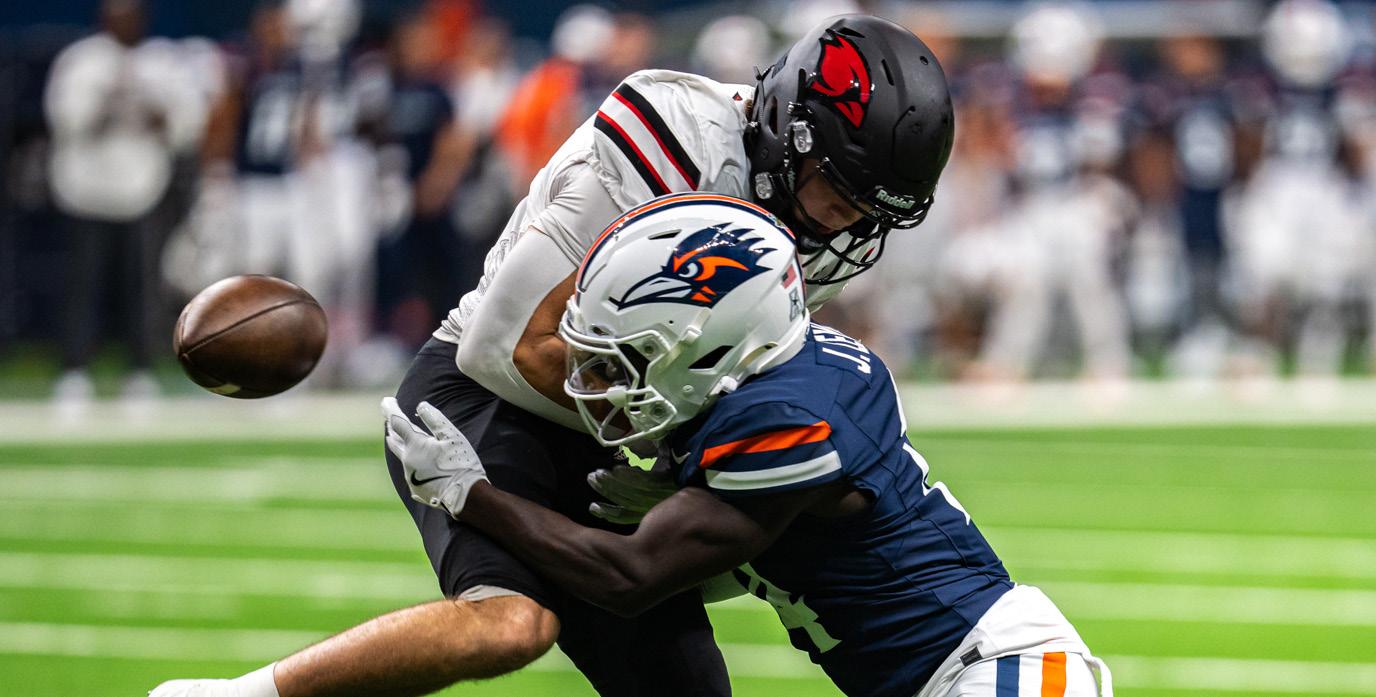
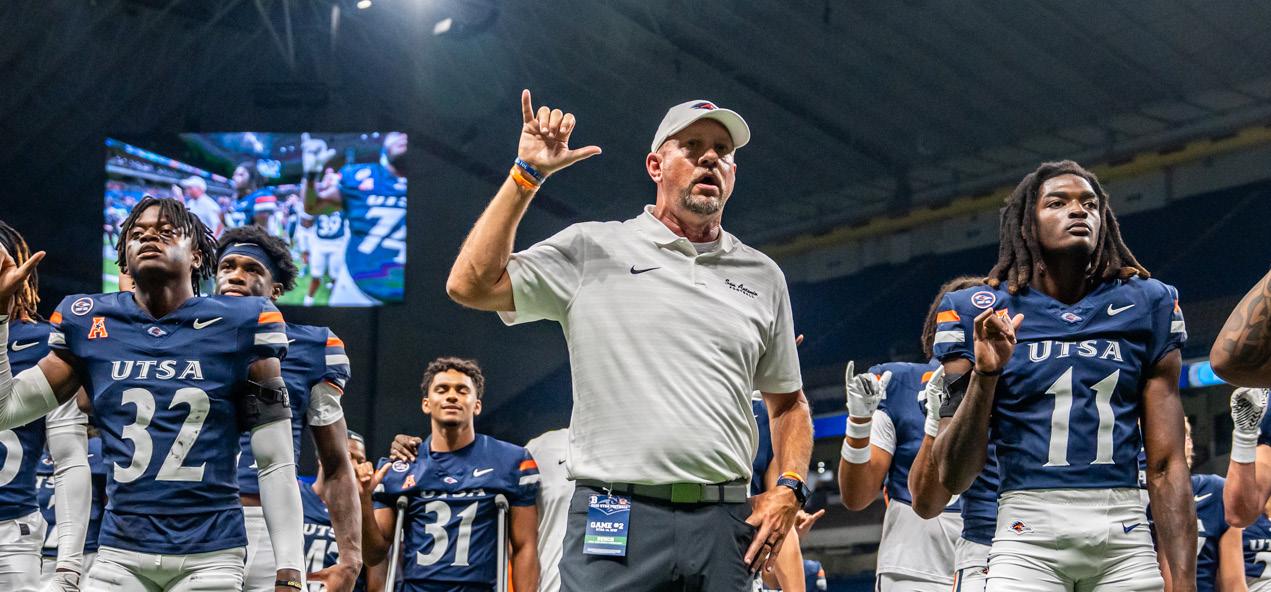

Henry Jr. continues hot streak; UTSA handles Incarnate Word
Roadrunners pick up first win of the season in dominant fashion
By Rylan Renteria Sports Editor
SAN ANTONIO — After dropping the first two games of the season, the Roadrunners couldn’t afford to lose to an FCS opponent at home. The ‘Runners needed to win, and they needed to do it in convincing fashion. UTSA football delivered, handing crosstown rival University of the Incarnate Word a 4820 loss on Saturday at the Alamodome.
The Roadrunners (1-2) wasted no time jumping on top of the Cardinals (1-2), holding a 24-point lead as both squads hit the locker rooms for halftime. Though there were questions on how the ‘Runners would perform against Incarnate Word, the inner-city contest ended up serving as a get-right game for a majority of UTSA’s star players, except for senior running back Robert Henry Jr. He’s been dominant all year for the Roadrunners, and it was
By Miles Jones Staff Photographer

business as usual for the nation’s leader in rushing yards on Saturday.
“First and foremost, and [Henry] will tell you this himself, it starts with those guys up front,” junior quarterback Owen McCown said after the game.
“Rob is a Sunday player. For him to be over 100 yards rushing once again, he’s always in the game no matter what. To get that first touchdown coming out the half with Rob breaking another long run was huge for us.”
In the opening possession for the Roadrunners, McCown led a six-play, 33-yard drive that culminated in a 13yard passing touchdown to junior wide receiver Devin McCuin. After a threeand-out from the Cardinals, UTSA sophomore kicker Michael Petro drilled a 26-yard field goal to put the ‘Runners up double digits.
Henry picked up his fifth touchdown of the season in the opening drive of the second quarter with a rushing score from three yards out. A forced fumble from senior safety Jermarius gave the ball right back to UTSA in the red zone, where McCown found senior tight end Dan Dishman for a four-yard passing touchdown.
Like clockwork, Henry broke free for a 74-yard rushing touchdown in
the opening drive of the second half, making him the first Roadrunner in program history with five-consecutive 100-yard rushing performances.
“For the first drive of the secnd half, I wouldn’t ignore [Henry’s] first carry,” coach Jeff Traylor said after the game. “He had a rough week, and he did a really good job of refocusing. I was really proud of him.”
The ‘Runners tacked on a couple scores before the clock hit double zeros — including a 77-yard receiving touchdown from junior wide receiver AJ Wilson — to secure the team’s first win of the season.
McCown put together his best performance of the season, going 29 of 35 for 238 yards and four touchdowns; Wilson aided him with a team-leading 99 reception yards. Henry racked up 144 yards and two touchdowns on the ground as UTSA outgained Incarnate Word in rushing yards 204 to 33. Senior linebacker Shad Banks Jr. snagged an interception for the second time in two weeks, and the Roadrunner defense registered 10 tackles-for-loss, four sacks and two forced fumbles. UTSA will head west for a matchup against Colorado State University at 8:30 p.m. Saturday at Canvas Stadium.
By Christopher Delgado Arts & Life Editor
SAN ANTONIO — UTSA hockey could not hold off Texas Tech University in its season opener, losing 2-1 in a shootout on Friday at the Ice and Golf Center at Northwoods. After a tumultuous overtime period, the game moved into a showdown. Texas Tech winger Connor Neal sent the puck to the back-corner net, sealing UTSA’s fate.
During the first period, UTSA desperately passed the puck to each other, leading to several turnovers and priming Texas Tech to score. However, PhD-candidate goalie Joe Spracklen’s reflexes were quick enough to thwart any attempts.
With seven minutes remaining in the first period, Texas Tech’s winger Kyler Plante smacked freshman defenseman Justin Trevino on the head with a hockey stick, sending Plante to the penalty box. Despite being in the power play, the Roadrunners failed to capitalize on the player imbalance. The rest of the period remained scoreless, but the aggression only increased as the clock wound down.
“[We] didn’t keep our heads right,” head coach Zac Swank commented on how the team faltered after the second period. “That’s what went wrong today.”

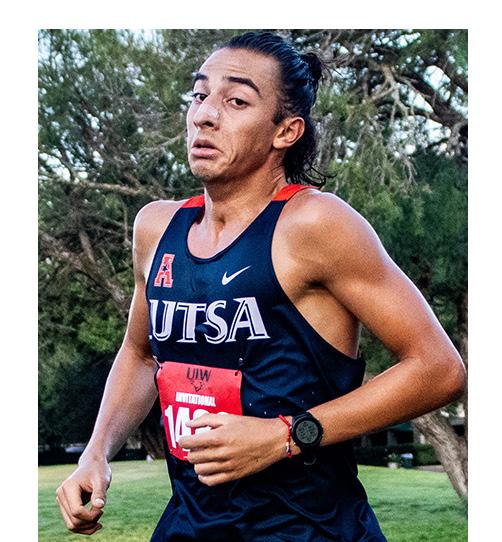
After a couple of shots on goal in the second period, UTSA managed to get on the scoreboard when Travis Sorce split the defense and shot from the near corner of the goal.
Texas Tech responded in the third period when winger Theoren Markusson weaved the puck past Spracklen into the net. With the game tied and 13 minutes remaining, tensions began to rise.
The Red Raiders finished the ‘Runners off when Neal slammed the biscuit right into the back corner of the net.
“We decided to play selfish hockey and let our emotions get the best of us,” Swank said regarding the destructive third period. “Top guys were getting kicked out unfortunately. We should’ve won that game — 100%. We should’ve won that game, just our heads kept us out of it.
“So that’s tomorrow’s game plan. Stick to what we did today. Build on that, but make it a complete 60-minute game, and keep our heads right,” Swank concluded.
Clockwise: Owen McCown, Shad Banks Jr., Robert Henry Jr., Jeff Traylor, Jermarius Lewis.
Aarien Foster/The Paisano
Armin Suljovic/The Paisano
Rylan Renteria/The Paisano
